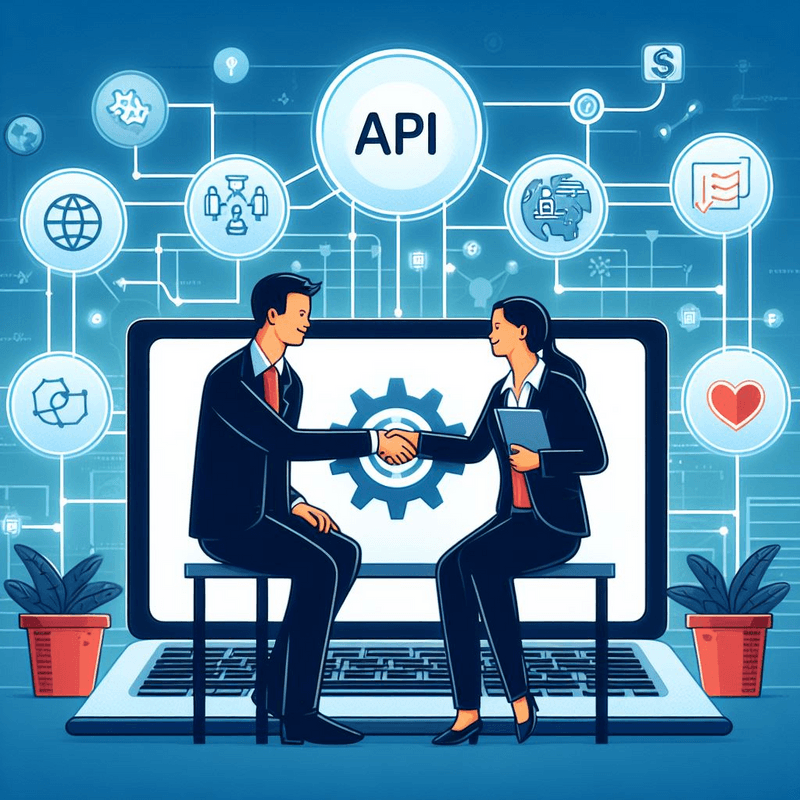What are Partner APIs and How Do They Work?
Partner APIs are a type of API designed to facilitate secure and controlled access between different business entities' systems, enhancing collaboration and integration.
Understanding the Role of Partner APIs
Partner APIs play a crucial role in today's interconnected digital ecosystem by allowing one business to access resources or services of another. Unlike public APIs, which are available to any developer, partner APIs require specific authorization, ensuring a higher level of security and control. This type of API is often used to expose a particular set of functionalities or data to trusted business partners, enabling seamless integration between different systems. Through API management tools and API gateways, companies can efficiently manage access rights, monitor API usage, and ensure that the data exchange complies with both parties' security and privacy standards.

Examples of Partner APIs in Action
A classic example of partner APIs in action is the integration between an e-commerce platform like Amazon and its third-party sellers or logistics providers. These APIs allow partners to automate transactions, manage inventory, and process orders directly through Amazon's platform, creating a more efficient workflow. Another example is in the travel industry, where booking platforms use partner APIs to aggregate flight, hotel, and car rental options from various providers, offering customers a composite solution that pulls data from multiple sources.
Benefits of Using Partner APIs
The use of partner APIs offers numerous benefits, including enhanced operational efficiency, as they automate processes that would otherwise require manual intervention. They also enable businesses to expand their service offerings by integrating with partners' capabilities, providing a more comprehensive solution to the end client. Furthermore, partner APIs facilitate a more agile response to market changes, as businesses can quickly adapt their services by integrating new functionalities provided by their partners. Additionally, through controlled access and data sharing, partner APIs help maintain data integrity and security, ensuring that sensitive information is only accessible to authorized parties.
Partner APIs represent a strategic tool for businesses looking to leverage their partnerships through technology. By facilitating secure, controlled access to specific functionalities and data between partners, these APIs enhance operational efficiency, expand service offerings, and maintain high security and privacy standards. Whether it's through enabling seamless transactions, automating inventory management, or creating composite service offerings, partner APIs provide a robust solution for businesses aiming to thrive in the digital age.
How to Connect to Partner APIs
Connecting to partner APIs is a strategic step for businesses looking to leverage external platforms and services to enhance their offerings.
Authentication Methods for Partner APIs
Authentication is a critical aspect of securely accessing partner APIs. The most common methods include OAuth and API keys. OAuth is particularly useful for scenarios where you need to perform actions on behalf of a user, as it provides temporary access tokens based on user consent. API keys, on the other hand, are a simpler method, acting as a secret token passed along with the HTTP request. Both methods ensure that only authorized parties can connect to and interact with the API, maintaining the security of private APIs while allowing you as a partner to perform necessary operations.
Utilizing API Gateways for Partner Integration
API gateways play a crucial role in managing and facilitating access to multiple data or service APIs, acting as a bridge between your application and the partner's platform. They help in routing requests, transforming protocols, applying policies for rate limiting, and handling authentication. By using an API gateway, businesses can streamline the integration process, ensuring that connections to different types of APIs—be it public API, open APIs, or more restricted partner APIs—are managed through a single, unified platform. This not only simplifies the API landscape but also enhances security and monitoring capabilities.
Best Practices for Securely Accessing Partner APIs
When accessing partner APIs, it's essential to follow best practices to ensure secure and reliable integration. Always use HTTPS to encrypt data in transit, protecting sensitive information from interception. Manage and store API keys and OAuth tokens securely, avoiding hard-coding them in your application's source code. Consider using an internal API developer portal to centralize access to documentation and credentials for all set of APIs you connect with. Additionally, be mindful of the partner's rate limits and data usage policies to maintain a good standing and ensure uninterrupted access to their services.
Connecting to partner APIs allows businesses to integrate a wide range of services and data into their platforms, enhancing their capabilities and offerings. By carefully managing authentication, utilizing API gateways for efficient integration, and adhering to best practices for security, companies can establish robust, secure connections with their partners' APIs. This strategic approach not only facilitates seamless data exchange and functionality expansion but also ensures that both parties can maintain the integrity and confidentiality of their shared data.

Types of APIs Utilized in Partner Integration
Partner integration through APIs is a strategic approach that enables businesses to extend their capabilities and offer enhanced services by connecting with strategic business partners.
Distinguishing Between Internal APIs and Partner APIs
Internal APIs are designed for use within an organization, allowing different teams or software systems to communicate and share data securely. These APIs provide a way to expose server functionalities to internal developers, facilitating operations like data retrieval or business logic execution without exposing them to the external world. In contrast, Partner APIs are specifically designed for interaction between business partners. They often require stricter control and monitoring mechanisms to ensure data security and integrity. While internal APIs might authenticate users through an internal IAM (Identity and Access Management) system, partner APIs might necessitate additional authorization protocols to verify and authenticate external partners, ensuring they can only perform operations within their scope.
Exploring the Different Models of Partner API Usage
Partner APIs come in various models, each tailored to specific types of interactions and data sharing needs. SOAP (Simple Object Access Protocol) and REST (Representational State Transfer) are two primary protocols used. SOAP APIs are protocol-based, known for their high security and transactional reliability, making them suitable for operations that require detailed messaging and transactions. REST APIs, built using REST principles, are more flexible and lightweight, ideal for web services that need to scale and handle multiple data requests efficiently. Depending on the nature of the partnership and the data or services being exchanged, businesses might choose one model over the other or employ a hybrid approach to cater to diverse integration needs.
Integrating Composite APIs for Complex Partner Interactions
Composite APIs are advanced constructs that allow for the combination of multiple operations into a single API call. This is particularly useful in complex partner interactions where a single business process might need to retrieve data from multiple sources or perform a series of actions across different systems. By integrating composite APIs, businesses can streamline processes, reduce server load, and improve the efficiency of data exchange with partners. These APIs are built using REST principles or other web services standards, offering a flexible and powerful way to handle intricate workflows and data interactions between strategic business partners.
APIs play a crucial role in enabling partner integration, offering a secure and efficient means to extend business capabilities and foster strategic partnerships. By understanding the distinctions between internal and partner APIs, exploring different models of API usage, and leveraging composite APIs for complex interactions, businesses can enhance their operational efficiency, improve data exchange, and create more value for their users and partners alike. Whether built using REST principles, SOAP, or a combination of protocols, the strategic use of APIs in partner integration is essential for modern businesses looking to thrive in an interconnected digital ecosystem.
Strategies for Leveraging Partner APIs
Leveraging partner APIs effectively can significantly enhance enterprise integration, offering a more seamless user experience and operational efficiency.
Optimizing Data Exchange Through Partner APIs
To optimize data exchange through partner APIs, consider utilizing GraphQL for its efficiency and flexibility in querying data. Unlike traditional REST APIs that may require multiple requests to gather related data, GraphQL allows clients to specify exactly what information they need in a single query. This not only reduces network overhead but also improves the speed and efficiency of data retrieval, making it ideal for complex use cases where data from multiple sources or related datasets need to be aggregated. Ensuring your API documentation is comprehensive and up-to-date is crucial for partners to get started and make the most out of the data exchange capabilities.
Utilizing API Management Platforms for Partner Collaboration
API management platforms play a critical role in facilitating partner collaboration by providing tools for publishing, documenting, and analyzing APIs that are available publicly or to a restricted set of third-party developers. These platforms offer features like rate limiting, access control, and usage analytics, which help in maintaining the performance and security of API ecosystems. By leveraging cloud-based API management solutions, enterprises can scale their API programs to accommodate partners of all shapes and sizes, ensuring that both the interface and the underlying data are accessible and reliable.
Implementing OAuth for Secure Partner Access to APIs
Implementing OAuth provides a robust framework for secure partner access to APIs, especially when sensitive information is being exchanged. OAuth allows for fine-grained access control, with tokens that can be scoped to specific actions or resources, adding an extra layer of validation and security. This is particularly important in scenarios where APIs are used to communicate between different enterprises or publicly expose data. By requiring partners to authenticate and authorize via OAuth, businesses can ensure that only authorized users can access their APIs, protecting both their own and their partners' data from unauthorized access.
Conclusion
Leveraging partner APIs requires a strategic approach focused on optimizing data exchange, utilizing management platforms for better collaboration, and implementing secure access protocols like OAuth. By adopting these strategies, enterprises can enhance their integration capabilities, offering more value through efficient, flexible, and secure data sharing. Whether it's through the use of advanced querying languages like GraphQL, leveraging cloud-based API management platforms, or ensuring secure access with OAuth, the goal is to create a seamless and productive partnership ecosystem that benefits all parties involved.
Knowl.io
Introducing Knowl.io, the revolutionary AI-driven platform designed to transform how API documentation is created and maintained. Say goodbye to the painstaking process of manually updating specifications with each code change—Knowl.io does the heavy lifting for you. With seamless integration into your development workflow, Knowl.io ensures your API documentation is perpetually accurate, reflecting the latest updates in your codebase without the need for manual annotations or explanations.
At the heart of Knowl.io is cutting-edge AI technology that meticulously identifies endpoints, parameters, and behaviors, crafting detailed and up-to-date API documentation with comprehensive explanations. Trust Knowl.io to elevate your documentation process, making it more efficient and reliable than ever. Ensure your developers and stakeholders always have access to the most current and coherent API documentation with Knowl.io, where innovation meets simplicity.


